A Reconstruction Methodology of Dynamic Construction Site Activities in 3D Digital Twin Models Based on Camera Information
Abstract
:1. Introduction
2. Related Works
2.1. The 3D Reconstruction of Static Construction Scenes and Elements
2.2. Detection of Static and Dynamic Elements at Construction Sites
2.3. Spatial Information Perception of Static and Dynamic Elements
2.4. Brief Summary
3. The 3D Reconstruction of the Dynamic Digital Twin Model
3.1. Geometric Features of the 3D Reconstruction of Construction Elements
3.1.1. Reconstruction Techniques Based on a Binocular Camera
3.1.2. Accuracy Analysis of Geometric Features Reconstruction
- 1.
- is the proportional relative error between the actual size of the elements and their point cloud dimensions;
- 2.
- denotes the ratio of the actual dimensions of length, width, and height for both the excavator and building;
- 3.
- denotes the ratio of the reconstructed point cloud dimensions of length, width, and height.
3.2. Detection of Construction Elements under Occlusion Scenarios
3.2.1. Expanded Dataset and Yolov8 with GAM_Attention Mechanism
3.2.2. Accuracy Analysis of Construction Elements Detection
3.3. Spatial Information Perception of Construction Elements
3.3.1. Principles of the Spatial Stereo Matching Algorithm Adopted
3.3.2. Accuracy Analysis of Spatial Information Perception
- 1.
- represents the numerical identifier assigned to the feature points extracted from the excavator;
- 2.
- denotes the numerical identifier assigned to the feature points extracted from the structure;
- 3.
- is the actual distance between the feature points of the excavator and building;
- 4.
- is the pixel distance between the feature points of the excavator and building.
3.3.3. Synchronous Detection and Localization of Construction Elements
3.4. Near Real-Time Projection Method for Integrating Dynamic Elements into the Static Model Base
3.4.1. Near Real-Time Projection Method
3.4.2. Accuracy Analysis of the Projection Method
- 1.
- represents the relative error of the DEP method;
- 2.
- denotes the ratio of distances between any two feature points in real space;
- 3.
- signifies the ratio of pixel distances between any two feature points in the 3D model;
- 4.
- , , , , , and denote the spatial coordinates of the feature points in the real world and 3D models;
- 5.
- , , and represent the identifiers of the feature points.
4. Experiment and Verification
4.1. Experimental Design and Procedure
4.2. Results and Discussion
- 1.
- indicates the ratio of movement distances between the initial and subsequent frames in the real scene;
- 2.
- denotes the pixel-based movement distances of feature points across frames in the model space;
- 3.
- and refer to the actual distances between feature points in the first and last two frames, respectively, in a real scene;
- 4.
- and represent the pixel-based distances in the model space. N is the total count of feature points;
- 5.
- is the total count of feature points;
- 6.
- denotes the relative error in the model’s dynamic reconstruction.
5. Conclusions
- (1)
- The accuracy of the 3D reconstruction technique based on binocular vision exceeds 95%.
- (2)
- The error of the elemental localization of the improved SGBM algorithm is less than 1.22%.
- (3)
- The YOLOv8 model is fused with the improved SGBM algorithm to realize near real-time detection and localization of target objects; [email protected] was over 0.995.
- (4)
- The accuracy of the near-real-time 2D-to-3D projection technique was over 0.97.
Author Contributions
Funding
Data Availability Statement
Conflicts of Interest
References
- Luo, R.; Sheng, B.; Lu, Y.; Huang, Y.; Fu, G.; Yin, X. Digital Twin Model Quality Optimization and Control Methods Based on Workflow Management. Appl. Sci. 2023, 13, 2884. [Google Scholar] [CrossRef]
- Tuhaise, V.V.; Tah, J.H.M.; Abanda, F.H. Technologies for digital twin applications in construction. Autom. Constr. 2023, 152, 104931. [Google Scholar] [CrossRef]
- Yang, C.; Lin, J.-R.; Yan, K.-X.; Deng, Y.-C.; Hu, Z.-Z.; Liu, C. Data-Driven Quantitative Performance Evaluation of Construction Supervisors. Buildings 2023, 13, 1264. [Google Scholar] [CrossRef]
- Zhong, B.; Gan, C.; Luo, H.; Xing, X. Ontology-based framework for building environmental monitoring and compliance checking under BIM environment. J. Affect. Disord. 2018, 141, 127–142. [Google Scholar] [CrossRef]
- Kavaliauskas, P.; Fernandez, J.B.; McGuinness, K.; Jurelionis, A. Automation of Construction Progress Monitoring by Integrating 3D Point Cloud Data with an IFC-Based BIM Model. Buildings 2022, 12, 1754. [Google Scholar] [CrossRef]
- Zhu, J.; Zeng, Q.; Han, F.; Jia, C.; Bian, Y.; Wei, C. Design of laser scanning binocular stereo vision imaging system and target measurement. Optik 2022, 270, 169994. [Google Scholar] [CrossRef]
- Sani, N.H.; Tahar, K.N.; Maharjan, G.R.; Matos, J.C.; Muhammad, M. 3D reconstruction of building model using UAV point clouds. Int. Arch. Photogramm. Remote Sens. Spat. Inf. Sci. 2022, 43, 455–460. [Google Scholar] [CrossRef]
- Dabetwar, S.; Kulkarni, N.N.; Angelosanti, M.; Niezrecki, C.; Sabato, A. Sensitivity analysis of unmanned aerial vehicle-borne 3D point cloud reconstruction from infrared images. J. Build. Eng. 2022, 58, 105070. [Google Scholar] [CrossRef]
- Zhao, S.; Kang, F.; Li, J.; Ma, C. Structural health monitoring and inspection of dams based on UAV photogrammetry with image 3D reconstruction. Autom. Constr. 2021, 130, 103832. [Google Scholar] [CrossRef]
- Kim, H.; Kim, H. 3D reconstruction of a concrete mixer truck for training object detectors. Autom. Constr. 2018, 88, 23–30. [Google Scholar] [CrossRef]
- Guan, J.; Yang, X.; Lee, V.C.; Liu, W.; Li, Y.; Ding, L.; Hui, B. Full field-of-view pavement stereo reconstruction under dynamic traffic conditions: Incorporating height-adaptive vehicle detection and multi-view occlusion optimization. Autom. Constr. 2022, 144, 104615. [Google Scholar] [CrossRef]
- Jiang, W.; Zhou, Y.; Ding, L.; Zhou, C.; Ning, X. UAV-based 3D reconstruction for hoist site mapping and layout planning in petrochemical construction. Autom. Constr. 2020, 113, 103137. [Google Scholar] [CrossRef]
- Liu, Z.; Kim, D.; Lee, S.; Zhou, L.; An, X.; Liu, M. Near Real-Time 3D Reconstruction and Quality 3D Point Cloud for Time-Critical Construction Monitoring. Buildings 2023, 13, 464. [Google Scholar] [CrossRef]
- An, X.; Zhou, L.; Liu, Z.; Wang, C.; Li, P.; Li, Z. Dataset and benchmark for detecting moving objects in construction sites. Autom. Constr. 2021, 122, 103482. [Google Scholar] [CrossRef]
- Wu, H.; Zhao, J. An intelligent vision-based approach for helmet identification for work safety. Comput. Ind. 2018, 100, 267–277. [Google Scholar] [CrossRef]
- Wu, J.; Cai, N.; Chen, W.; Wang, H.; Wang, G. Automatic detection of hardhats worn by construction personnel: A deep learning approach and benchmark dataset. Autom. Constr. 2019, 106, 102894. [Google Scholar] [CrossRef]
- Liu, D.; Sun, J.; Lu, W.; Li, S.; Zhou, X. 3D reconstruction of the dynamic scene with high-speed targets for GM-APD lidar. Opt. Laser Technol. 2023, 161, 109114. [Google Scholar] [CrossRef]
- Chu, C.-C.; Nandhakumar, N.; Aggarwal, J. Image segmentation using laser radar data. Pattern Recognit. 1990, 23, 569–581. [Google Scholar] [CrossRef]
- Verykokou, S.; Ioannidis, C. An Overview on Image-Based and Scanner-Based 3D Modeling Technologies. Sensors 2023, 23, 596. [Google Scholar] [CrossRef]
- Hosamo, H.H.; Hosamo, M.H. Digital Twin Technology for Bridge Maintenance using 3D Laser Scanning: A Review. Adv. Civ. Eng. 2022, 2022, 2194949. [Google Scholar] [CrossRef]
- Liu, T.; Wang, N.; Fu, Q.; Zhang, Y.; Wang, M. Research on 3D Reconstruction Method Based on Laser Rotation Scanning. In Proceedings of the 2019 IEEE International Conference on Mechatronics and Automation (ICMA), Tianjin, China, 4–7 August 2019; pp. 1600–1604. [Google Scholar] [CrossRef]
- Yu, Q.; Helmholz, P.; Belton, D. Semantically Enhanced 3D Building Model Reconstruction from Terrestrial Laser-Scanning Data. J. Surv. Eng. 2017, 143, 04017015. [Google Scholar] [CrossRef]
- Pérez, G.; Escolà, A.; Rosell-Polo, J.R.; Coma, J.; Arasanz, R.; Marrero, B.; Cabeza, L.F.; Gregorio, E. 3D characterization of a Boston Ivy double-skin green building facade using a LiDAR system. J. Affect. Disord. 2021, 206, 108320. [Google Scholar] [CrossRef]
- Abdulwahab, S.; Rashwan, H.A.; Garcia, M.A.; Masoumian, A.; Puig, D. Monocular depth map estimation based on a multi-scale deep architecture and curvilinear saliency feature boosting. Neural Comput. Appl. 2022, 34, 16423–16440. [Google Scholar] [CrossRef]
- Jin, S.; Ou, Y. Feature-Based Monocular Dynamic 3D Object Reconstruction; Social Robotics. In Proceedings of the 10th International Conference, ICSR 2018, Qingdao, China, 28–30 November 2018; Proceedings 10; Springer: Berlin/Heidelberg, Germany, 2018; pp. 380–389. [Google Scholar] [CrossRef]
- Ni, Z.; Burks, T.F.; Lee, W.S. 3D Reconstruction of Plant/Tree Canopy Using Monocular and Binocular Vision. J. Imaging 2016, 2, 28. [Google Scholar] [CrossRef]
- Deng, L.; Sun, T.; Yang, L.; Cao, R. Binocular video-based 3D reconstruction and length quantification of cracks in concrete structures. Autom. Constr. 2023, 148, 104743. [Google Scholar] [CrossRef]
- Yin, H.; Lin, Z.; Yeoh, J.K. Semantic localization on BIM-generated maps using a 3D LiDAR sensor. Autom. Constr. 2023, 146, 104641. [Google Scholar] [CrossRef]
- Hane, C.; Zach, C.; Cohen, A.; Pollefeys, M. Dense Semantic 3D Reconstruction. IEEE Trans. Pattern Anal. Mach. Intell. 2016, 39, 1730–1743. [Google Scholar] [CrossRef]
- Stathopoulou, E.-K.; Remondino, F. Semantic photogrammetry—Boosting image-based 3D reconstruction with semantic labeling. ISPRS—Int. Arch. Photogramm. Remote. Sens. Spat. Inf. Sci. 2019, 42, 685–690. [Google Scholar] [CrossRef]
- Tong, C. Three-dimensional reconstruction of the dribble track of soccer robot based on heterogeneous binocular vision. J. Ambient. Intell. Humaniz. Comput. 2020, 11, 6361–6372. [Google Scholar] [CrossRef]
- Li, J.; Gao, W.; Wu, Y.; Liu, Y.; Shen, Y. High-quality indoor scene 3D reconstruction with RGB-D cameras: A brief review. Comput. Vis. Media 2022, 8, 369–393. [Google Scholar] [CrossRef]
- Sung, C.; Kim, P.Y. 3D terrain reconstruction of construction sites using a stereo camera. Autom. Constr. 2016, 64, 65–77. [Google Scholar] [CrossRef]
- Kim, D.; Liu, M.; Lee, S.; Kamat, V.R. Remote proximity monitoring between mobile construction resources using camera-mounted UAVs. Autom. Constr. 2019, 99, 168–182. [Google Scholar] [CrossRef]
- Fang, Q.; Li, H.; Luo, X.; Ding, L.; Rose, T.M.; An, W.; Yu, Y. A deep learning-based method for detecting non-certified work on construction sites. Adv. Eng. Inform. 2018, 35, 56–68. [Google Scholar] [CrossRef]
- Luo, X.; Li, H.; Cao, D.; Dai, F.; Seo, J.; Lee, S. Recognizing Diverse Construction Activities in Site Images via Relevance Networks of Construction-Related Objects Detected by Convolutional Neural Networks. J. Comput. Civ. Eng. 2018, 32, 04018012. [Google Scholar] [CrossRef]
- Roberts, D.; Golparvar-Fard, M. End-to-end vision-based detection, tracking and activity analysis of earthmoving equipment filmed at ground level. Autom. Constr. 2019, 105, 102811. [Google Scholar] [CrossRef]
- Kim, H.; Kim, H.; Hong, Y.W.; Byun, H. Detecting Construction Equipment Using a Region-Based Fully Convolutional Network and Transfer Learning. J. Comput. Civ. Eng. 2018, 32, 04017082. [Google Scholar] [CrossRef]
- Wang, C.; Cui, X.; Zhao, S.; Guo, K.; Wang, Y.; Song, Y. The application of deep learning in stereo matching and disparity estimation: A bibliometric review. Expert Syst. Appl. 2023, 238, 122006. [Google Scholar] [CrossRef]
- Zhang, Y.; Gu, J.; Rao, T.; Lai, H.; Zhang, B.; Zhang, J.; Yin, Y. A Shape Reconstruction and Measurement Method for Spherical Hedges Using Binocular Vision. Front. Plant Sci. 2022, 13, 849821. [Google Scholar] [CrossRef]
- Gai, Q. Optimization of Stereo Matching in 3D Reconstruction Based on Binocular Vision. J. Phys. Conf. Ser. 2018, 960, 012029. [Google Scholar] [CrossRef]
- Hu, Y. Research on a three-dimensional reconstruction method based on the feature matching algorithm of a scale-invariant feature transform. Math. Comput. Model. 2011, 54, 919–923. [Google Scholar] [CrossRef]
- Xiang, R.; Jiang, H.; Ying, Y. Recognition of clustered tomatoes based on binocular stereo vision. Comput. Electron. Agric. 2014, 106, 75–90. [Google Scholar] [CrossRef]
- Xu, Y.; Liu, K.; Ni, J.; Li, Q. 3D reconstruction method based on second-order semiglobal stereo matching and fast point positioning Delaunay triangulation. PLoS ONE 2022, 17, e0260466. [Google Scholar] [CrossRef] [PubMed]
- Cai, H.; Andoh, A.R.; Su, X.; Li, S. A boundary condition based algorithm for locating construction site objects using RFID and GPS. Adv. Eng. Inform. 2014, 28, 455–468. [Google Scholar] [CrossRef]
- Chen, P.-Y.; Lin, H.-Y.; Pai, N.-S.; Huang, J.-B. Construction of Edge Computing Platform Using 3D LiDAR and Camera Heterogeneous Sensing Fusion for Front Obstacle Recognition and Distance Measurement System. Processes 2022, 10, 1876. [Google Scholar] [CrossRef]
- Yang, Z.; Yuan, Y.; Zhang, M.; Zhao, X.; Zhang, Y.; Tian, B. Safety Distance Identification for Crane Drivers Based on Mask R-CNN. Sensors 2019, 19, 2789. [Google Scholar] [CrossRef] [PubMed]
- Maini, R.; Aggarwal, H. A comprehensive review of image enhancement techniques. arXiv 2010, arXiv:1003.4053. [Google Scholar] [CrossRef]
- Shukla, K.N. A Review on Image Enhancement Techniques. Int. J. Eng. Appl. Comput. Sci. 2017, 2, 232–235. [Google Scholar] [CrossRef]
- Liang, H.; Liu, M.; Hui, M.; Zhao, Y.; Dong, L.; Kong, L. 3D reconstruction of typical entities based on multi-perspective images. In Optical Metrology and Inspection for Industrial Applications IX; SPIE: Bellingham, WA, USA, 2022; Volume 12319, pp. 338–345. [Google Scholar] [CrossRef]
- Yang, Q.; Yang, J.H. A Kruppa Equation-Based Virtual Reconstruction Method for 3D Images Under Visual Communication Scenes. IEEE Access 2023, 11, 143721–143730. [Google Scholar] [CrossRef]
- Barzi, F.K.; Nezamabadi-Pour, H. Automatic objects’ depth estimation based on integral imaging. Multimed. Tools Appl. 2022, 81, 43531–43549. [Google Scholar] [CrossRef]
- Weng, Z.; He, D.; Zheng, Y.; Zheng, Z.; Zhang, Y.; Gong, C. Research on 3D reconstruction method of cattle face based on image. J. Intell. Fuzzy Syst. 2023, 44, 10551–10563. [Google Scholar] [CrossRef]
- Yuan, J.; Zhu, S.; Tang, K.; Sun, Q. ORB-TEDM: An RGB-D SLAM Approach Fusing ORB Triangulation Estimates and Depth Measurements. IEEE Trans. Instrum. Meas. 2022, 71, 1–15. [Google Scholar] [CrossRef]
- Katsigiannis, S.; Seyedzadeh, S.; Agapiou, A.; Ramzan, N. Deep learning for crack detection on masonry façades using limited data and transfer learning. J. Build. Eng. 2023, 76, 107105. [Google Scholar] [CrossRef]
- Feng, W.; Liang, Z.; Mei, J.; Yang, S.; Liang, B.; Zhong, X.; Xu, J. Petroleum Pipeline Interface Recognition and Pose Detection Based on Binocular Stereo Vision. Processes 2022, 10, 1722. [Google Scholar] [CrossRef]
- Xiong, X.; Wang, K.; Chen, J.; Li, T.; Lu, B.; Ren, F. A Calibration System of Intelligent Driving Vehicle Mounted Scene Projection Camera Based on Zhang Zhengyou Calibration Method. In Proceedings of the 2022 34th Chinese Control and Decision Conference (CCDC), Hefei, China, 15–17 August 2022; pp. 747–750. [Google Scholar]
- Tang, Y.; Xi, C.; Gong, Z.; Li, L. Scoliosis Detection Based on Feature Extraction from Region-of-Interest. Trait. Signal 2022, 39, 815–822. [Google Scholar] [CrossRef]



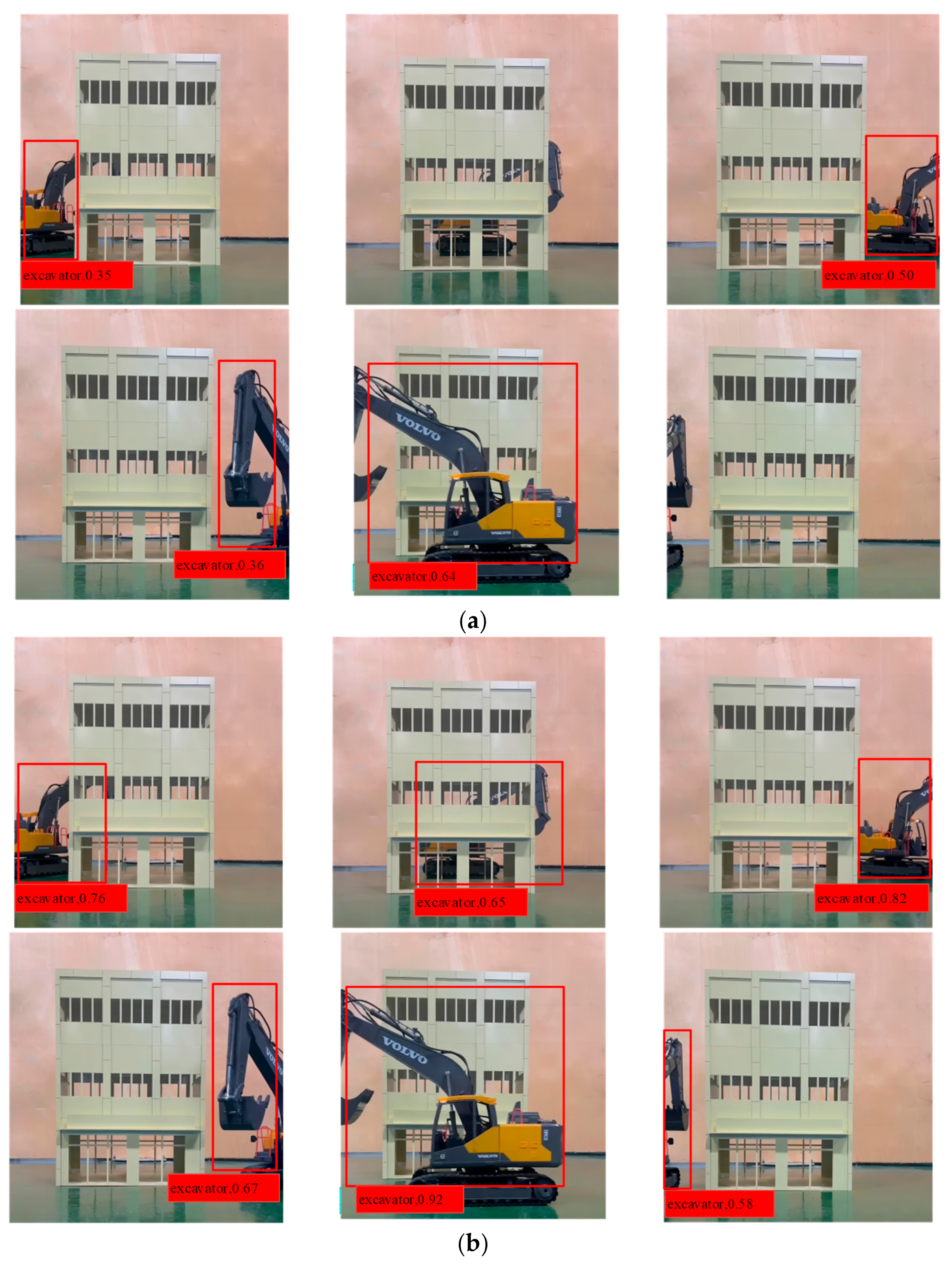


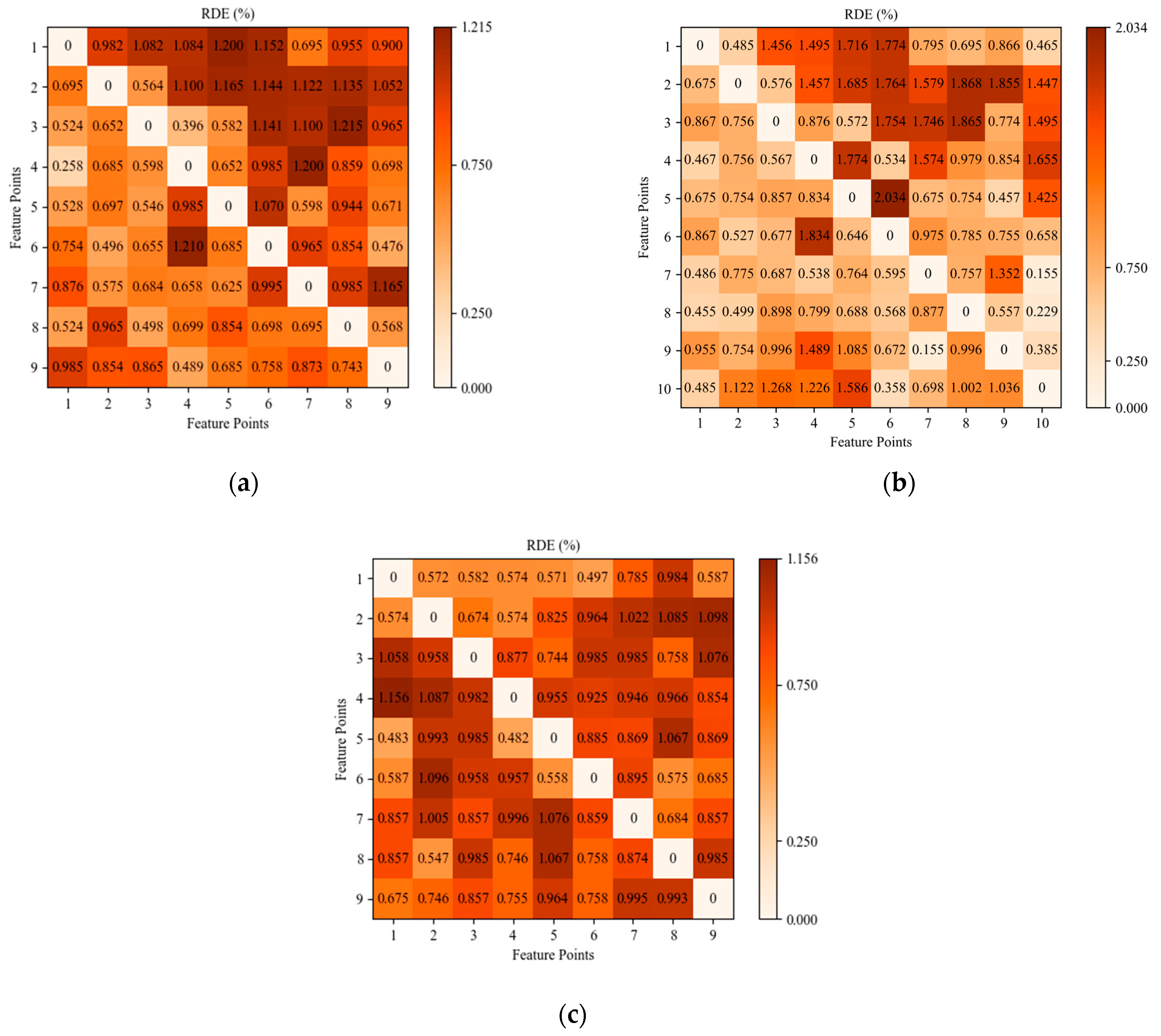
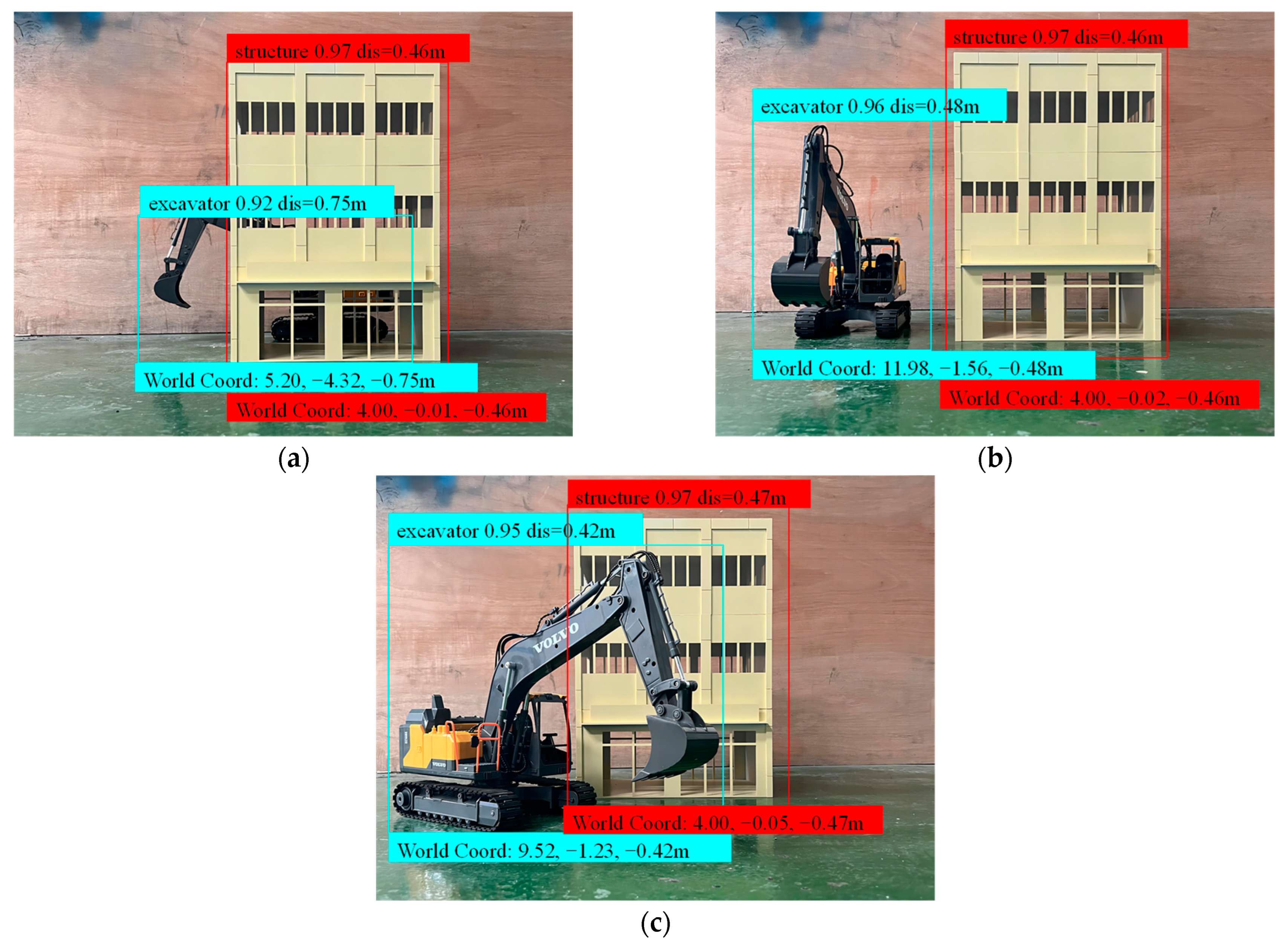
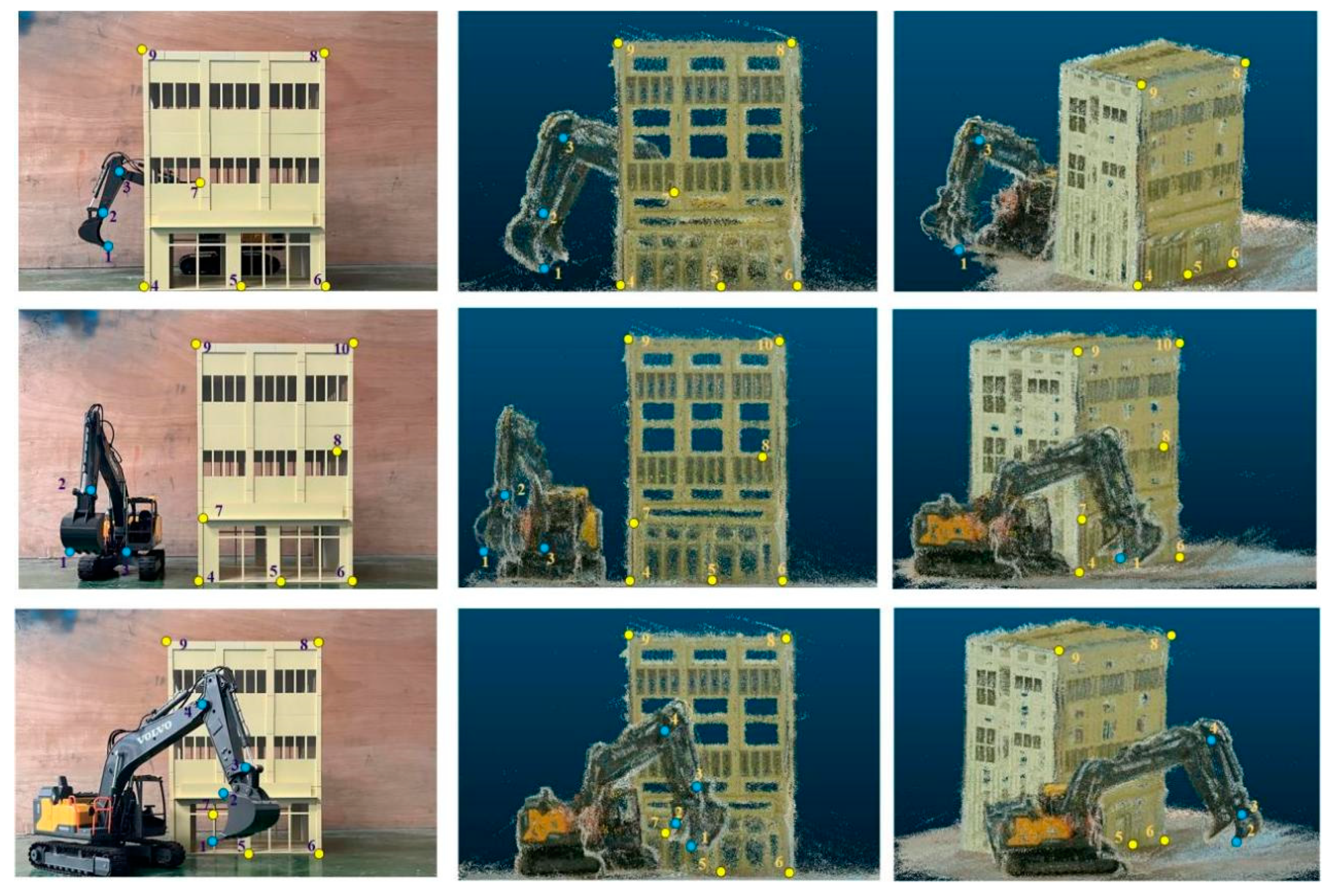
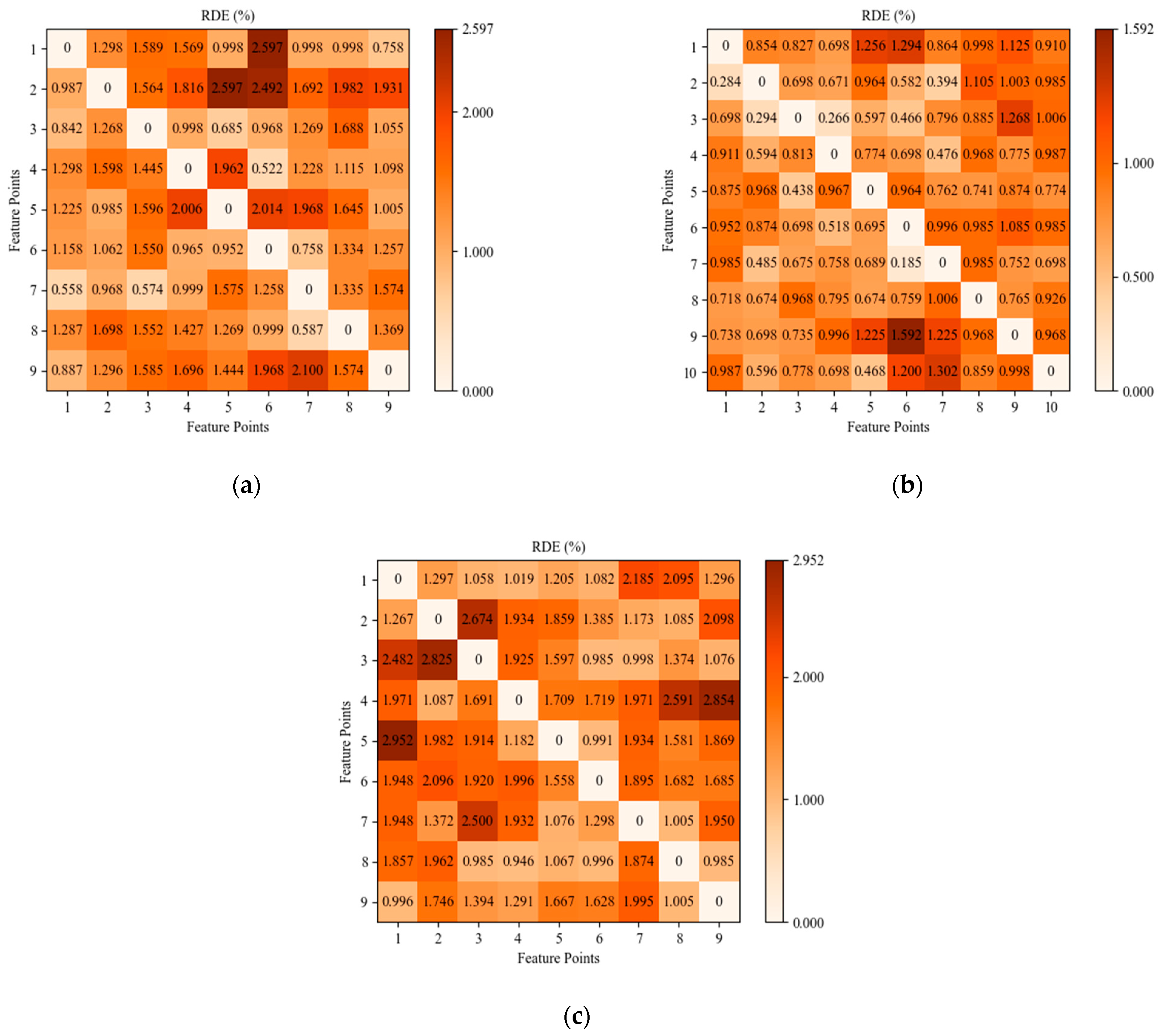
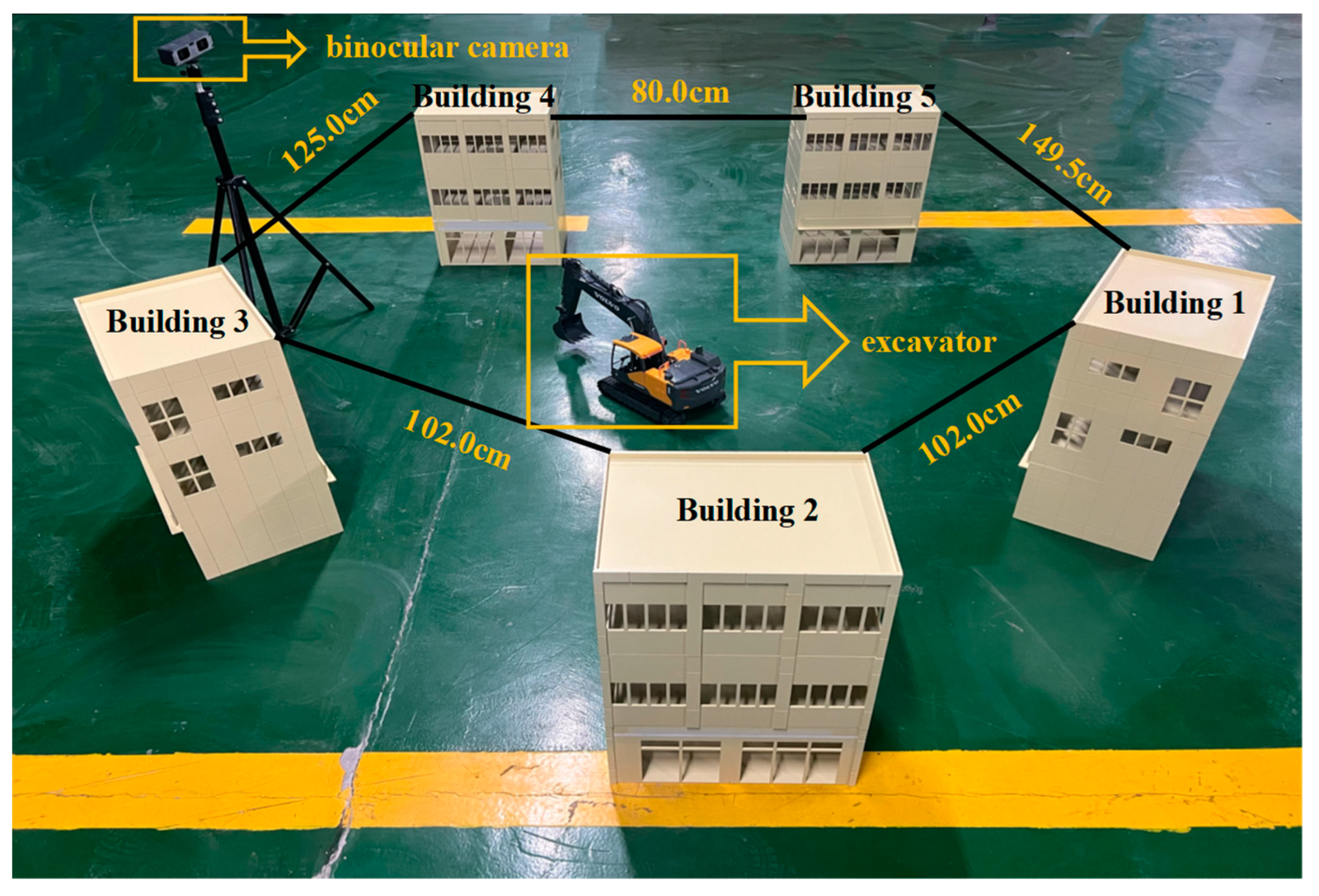
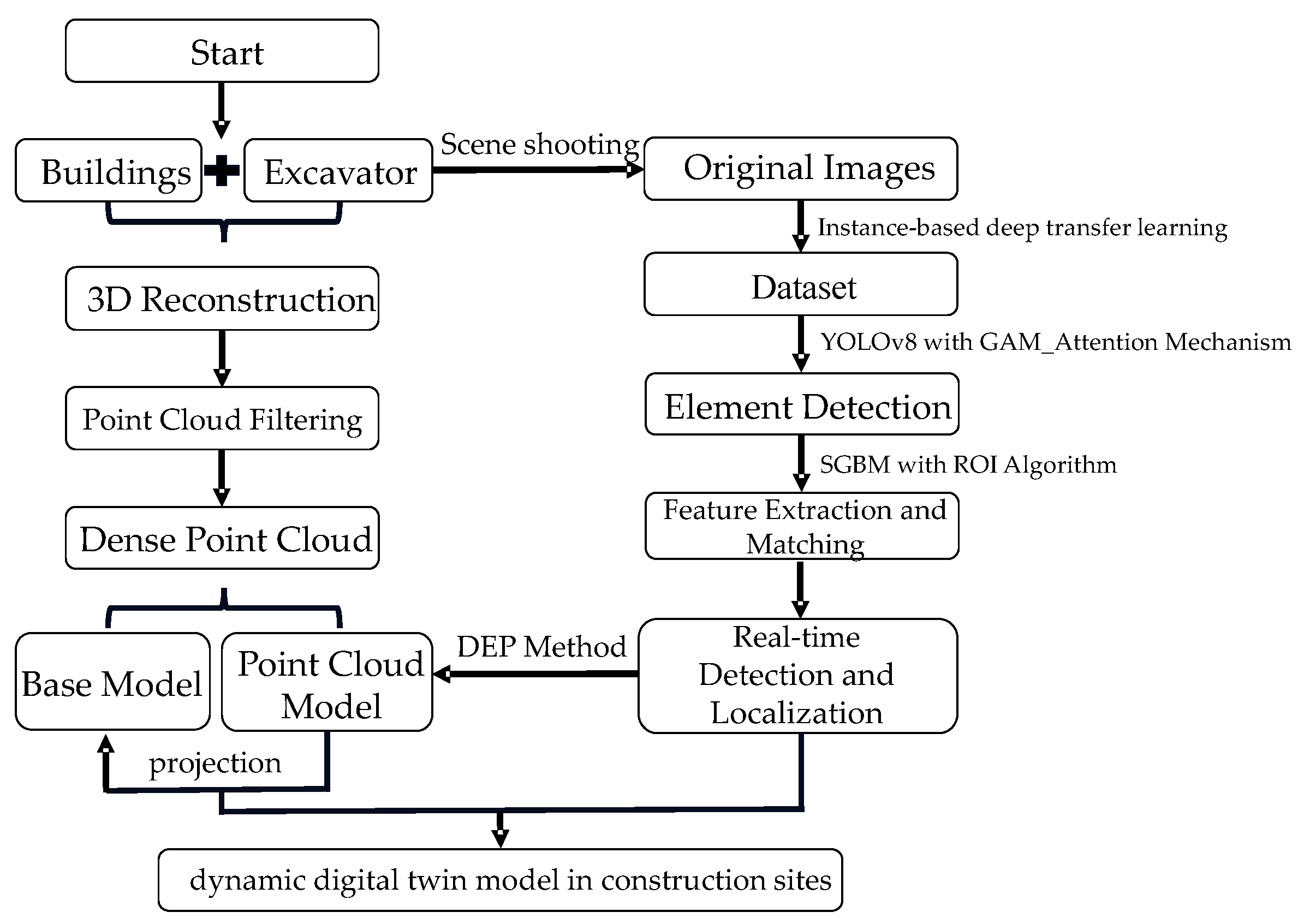
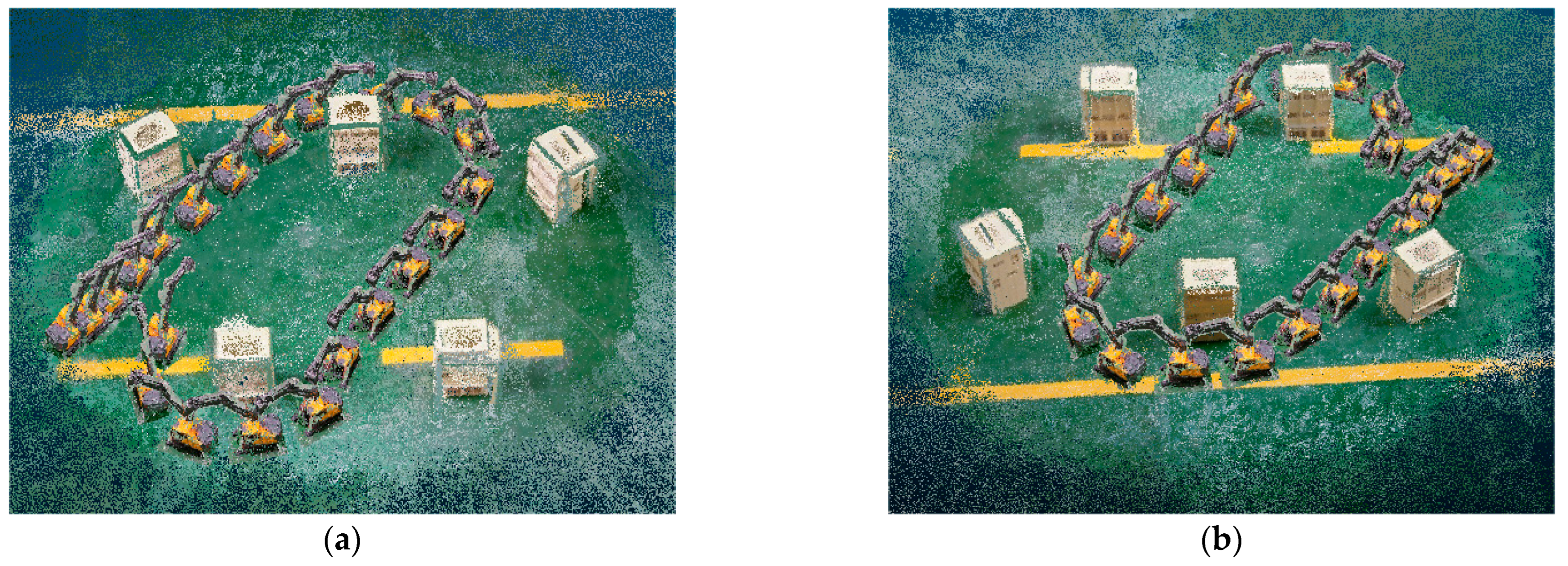
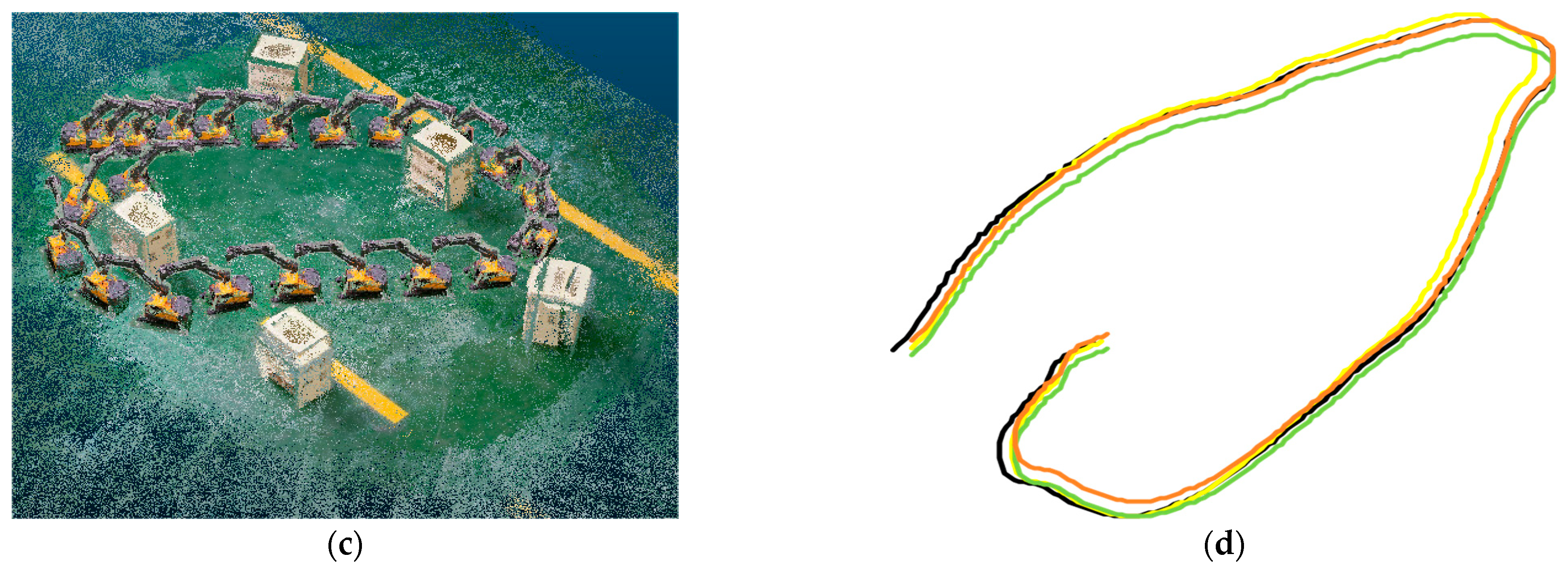
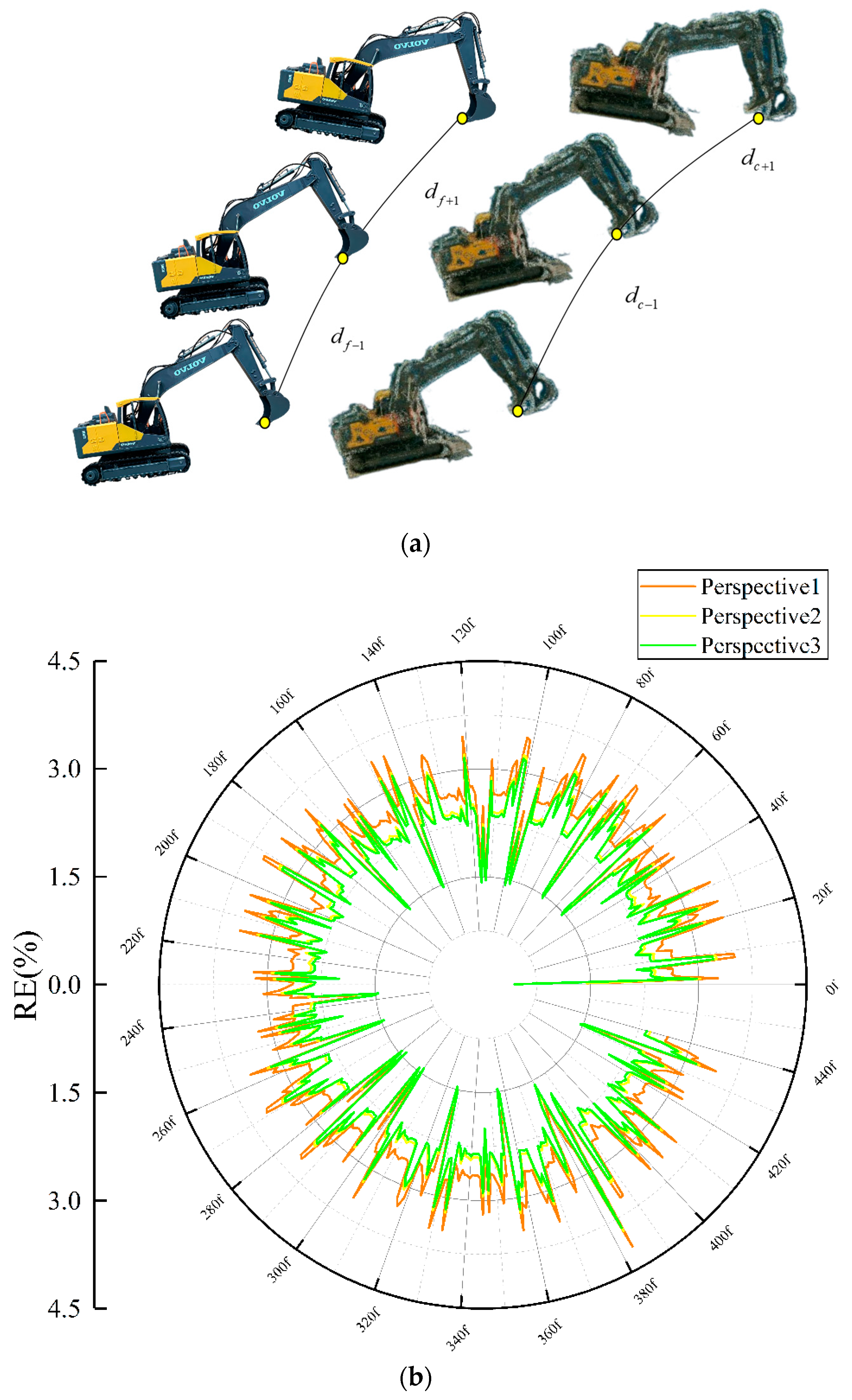
| Elements | Actual Size (cm) | SL,W,H | Point Cloud | Sl,w,h | RE (%) | ||||
|---|---|---|---|---|---|---|---|---|---|
| Length | Width | Height | Length | Width | Height | ||||
| Building | 37.5 | 28.1 | 50.0 | 1:0.75:1.33 | 37.9 | 28.2 | 49.8 | 1:0.75:1.31 | 1.5 |
| Excavator | 61.0 | 17.0 | 41.0 | 1:0.28:0.67 | 62.8 | 17.5 | 40.5 | 1:0.28:0.64 | 4.5 |
| IOU | [email protected] | |||
|---|---|---|---|---|
| YOLOv8n | YOLOv8n + GAM | YOLOv8n + CBAM | YOLOv8n + SE | |
| 0.1 | 0.640 | 0.758 | 0.762 | 0.665 |
| 0.2 | 0.788 | 0.972 | 0.974 | 0.870 |
| 0.3 | 0.797 | 0.975 | 0.975 | 0845 |
| 0.4 | 0.800 | 0.974 | 0.975 | 0.870 |
| 0.5 | 0.854 | 0.990 | 0.989 | 0.925 |
| 0.6 | 0.876 | 0.995 | 0.982 | 0.948 |
| 0.8 | 0.759 | 0.955 | 0.931 | 0.936 |
| 0.9 | 0.770 | 0.955 | 0.955 | 0.962 |
| 1 | 0.790 | 0.948 | 0.945 | 0.935 |
Disclaimer/Publisher’s Note: The statements, opinions and data contained in all publications are solely those of the individual author(s) and contributor(s) and not of MDPI and/or the editor(s). MDPI and/or the editor(s) disclaim responsibility for any injury to people or property resulting from any ideas, methods, instructions or products referred to in the content. |
© 2024 by the authors. Licensee MDPI, Basel, Switzerland. This article is an open access article distributed under the terms and conditions of the Creative Commons Attribution (CC BY) license (https://creativecommons.org/licenses/by/4.0/).
Share and Cite
He, J.; Li, P.; An, X.; Wang, C. A Reconstruction Methodology of Dynamic Construction Site Activities in 3D Digital Twin Models Based on Camera Information. Buildings 2024, 14, 2113. https://doi.org/10.3390/buildings14072113
He J, Li P, An X, Wang C. A Reconstruction Methodology of Dynamic Construction Site Activities in 3D Digital Twin Models Based on Camera Information. Buildings. 2024; 14(7):2113. https://doi.org/10.3390/buildings14072113
Chicago/Turabian StyleHe, Jingyao, Pengfei Li, Xuehui An, and Chengzhi Wang. 2024. "A Reconstruction Methodology of Dynamic Construction Site Activities in 3D Digital Twin Models Based on Camera Information" Buildings 14, no. 7: 2113. https://doi.org/10.3390/buildings14072113





